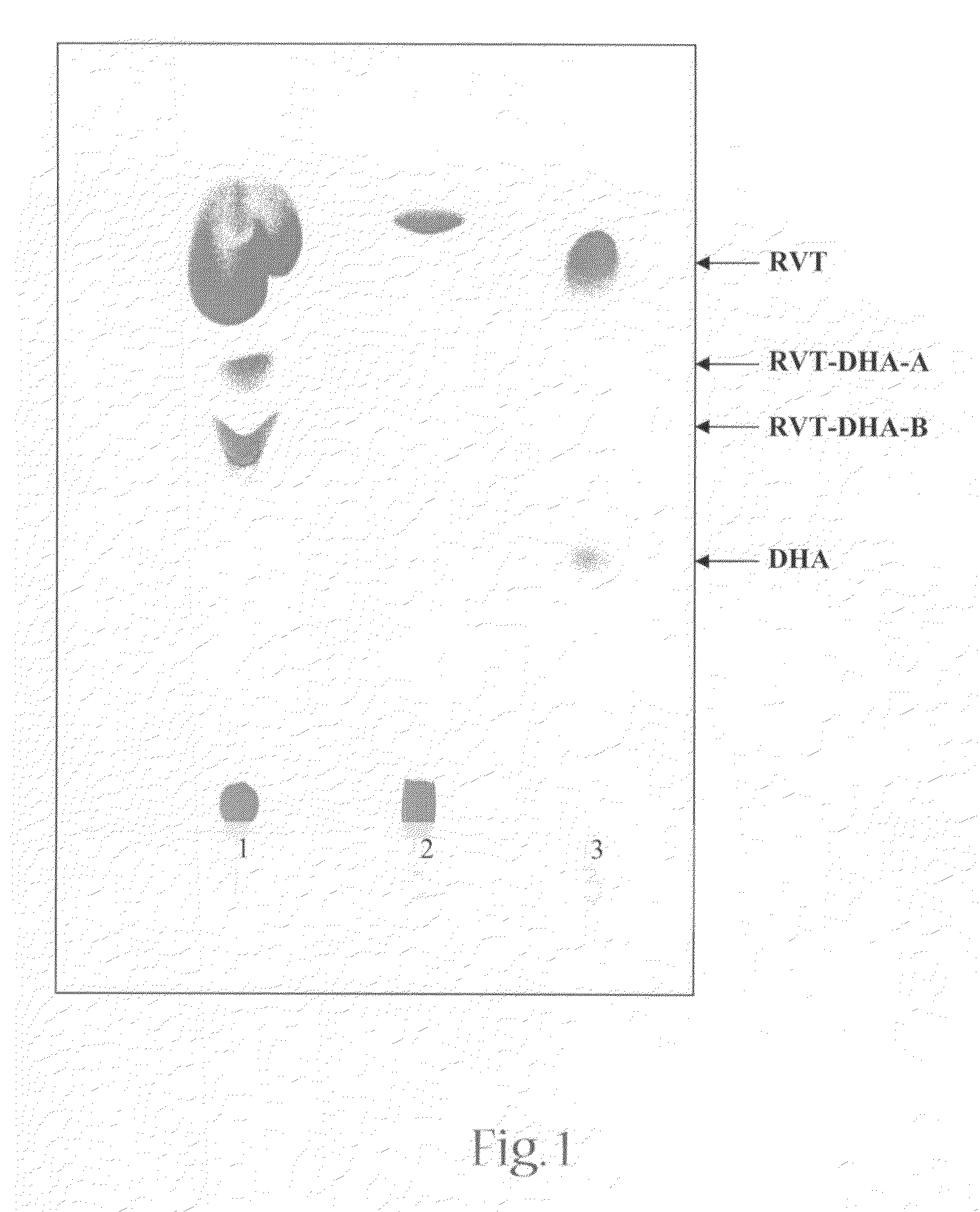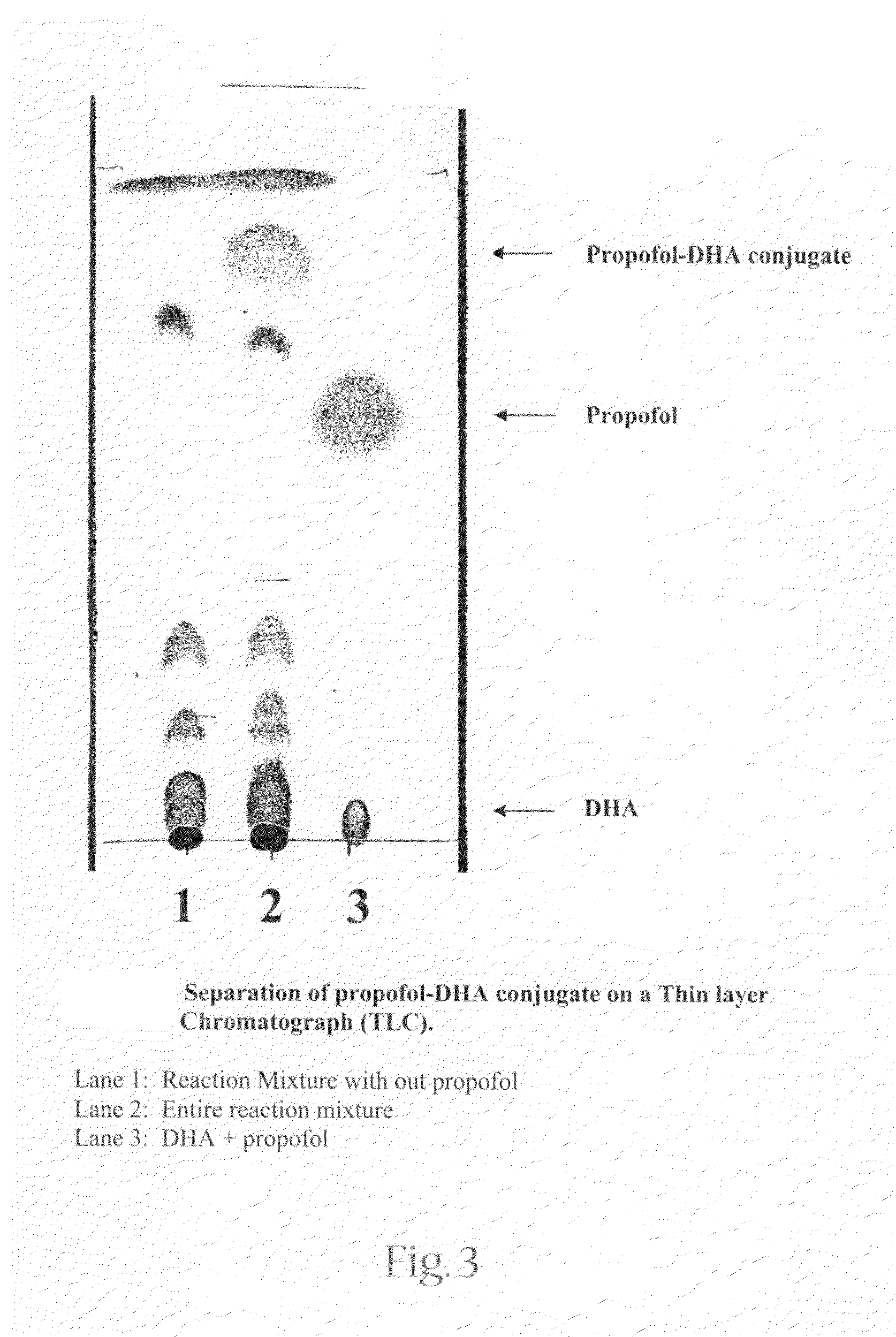Fatty acid phenolic conjugates
a technology of phenolic conjugates and fatty acids, applied in the field of fatty acid phenolic conjugates, can solve the problems of inability to penetrate cells very effectively, insufficient number or type of cell receptors and transport systems, and inability to activate intracellular enzymes or the activity of systems such as lysosomes or microtubules, etc., to enhance the cytotoxic effect of dha, inhibit cell growth, and evaluate the anti-proliferative activity
- Summary
- Abstract
- Description
- Claims
- Application Information
AI Technical Summary
Problems solved by technology
Method used
Image
Examples
example 1
Synthesis of Resveratrol Ester of Docosahexaenoic Acid
[0044]The synthesis of the resveratrol ester of docosahexaenoic acid was performed in two steps. In the first step, the docosahexaenoic-anhydride was synthesized, and in a second step this anhydride was coupled to resveratrol.
[0045]For the initial step to form the anhydride, docosahexaenoic acid (DHA, 0.19 μM), dicyclohexylcarbodiimide (DCC, 0.145 μM), and the anti-oxidant butylated hydroxytoluene (BHT, 1.5 μM) were dissolved in 4 mls of dimethylformamide (DMF) and mixed for one hour at room temperature under an atmosphere of nitrogen. In the second step, resveratrol (RVT) (0.095, μM) and 4-dimethylaminopyridine (DMAP, 0.095 μM) were then added to the DHA-anhydride mixture. The resulting solution was stirred at room temperature under an atmosphere of nitrogen for about 17 hours. The reaction product was filtered, washed with chloroform, and then separated by analytical thin layer chromatography (TLC). The TLC plate was developed ...
example 2
Synthesis, Purification and Characterization of 2,6 Diisopropylphenyldocosa-Hexaenoate (Propofol-DHA)
Synthesis
[0046]To minimize auto-oxidation, all procedures were performed in reduced light and under nitrogen. The reaction was carried out in two steps: synthesis of docosahexaenoic acid anhydride (DHA-anhydride), subsequently followed by the esterification of DHA by 2,6 diisopropylphenol(propofol).
[0047]DHA (100 mg, 0.305 mmol), a coupling reagent, N,N′-dicyclohexylcarbodiimide (94 mg, 0.450 mmol), and an anti-oxidant, 2,6 di-tert-butyl-4 methylphenol (BHT) (5 mg) were dissolved in 5 ml of chloroform. The reaction was stirred for 60 min at room temperature. propofol (49.8 mg, 0.28 mmol) and 4-(dimethyl amino) pyridine (18.5 mg, 0.152 mmol were then added to the reaction. The resulting mixture was stirred for a period of 12 hours; the reaction suspension was then filtered and washed with petroleum ether and subjected to purification.
Purification
[0048]The product of the reaction was p...
example 3
Synthesis, Purification and Characterization of 2,6-Diisopropylphenyl Eicosopentenoate (Propofol-EPA)
[0056]A propofol-EPA conjugate was also synthesized and characterized using similar synthetic and analytical approaches as those described above for the propofol-DHA conjugate.
PUM
| Property | Measurement | Unit |
|---|---|---|
| thickness | aaaaa | aaaaa |
| retention time | aaaaa | aaaaa |
| pH | aaaaa | aaaaa |
Abstract
Description
Claims
Application Information
 Login to View More
Login to View More - R&D Engineer
- R&D Manager
- IP Professional
- Industry Leading Data Capabilities
- Powerful AI technology
- Patent DNA Extraction
Browse by: Latest US Patents, China's latest patents, Technical Efficacy Thesaurus, Application Domain, Technology Topic, Popular Technical Reports.
© 2024 PatSnap. All rights reserved.Legal|Privacy policy|Modern Slavery Act Transparency Statement|Sitemap|About US| Contact US: help@patsnap.com










